In General, What Happens To Climate As The Latitude Increases?
Earth is a dynamic planet, constantly undergoing modify driven by internal and external forces. Currents of magma within our planet motility the plates that grade the continental crust in a constant process that builds mountains and creates valleys. These valleys may eventually become lakes, seas, and oceans. On the surface, the greatest factor affecting Globe is sunlight. Sunday provides energy for living organisms, and it drives our planet's weather condition and climate past creating temperature gradients in the temper and oceans.
Atmospheric Apportionment
The sun's rays provide both calorie-free and heat to Globe, and regions that receive greater exposure warm to a greater extent. This is particularly truthful of the tropics, which experience less seasonal variation in incident sunlight. Moisture-laden tropical air warms, becomes less dense, and rises. But every bit air reaches the upper levels of the temper, information technology cools. Water molecules condense to form clouds and eventually fall as rain. Warm air ascent from Earth's surface pushes the air mass away from the equator, and releases its moisture every bit precipitation as it travels pole-ward (Figure 1).
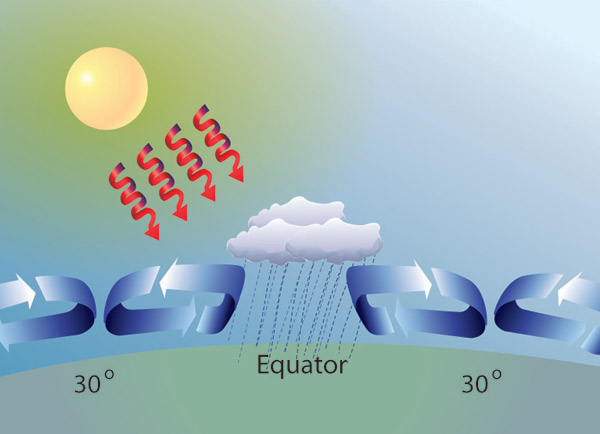
Figure 1: Bicycle of evaporation, condensation, and precipitation
Areas in the tropics receive greater incident sunlight throughout the year, which causes h2o to evaporate. The moisture-laden air travels abroad from the equator, losing atmospheric precipitation as it goes.
If the Earth did not spin on its axis, this bicycle of evaporation, condensation, and precipitation would move h2o and air forth a north-s axis from the equator to the poles. This, notwithstanding, does not happen. Earth's spin creates three belts of circulation (Figure 2). Air circulates from the torrid zone to regions approximately 30° north and south breadth, where the air masses sink. This belt of air apportionment is referred to as a Hadley cell, after George Hadley, who first described information technology (Holton 2004). Two additional belts of circulating air exist in the temperate latitudes (between 30° and 60° latitude) and most the poles (between 60° and xc° latitude).
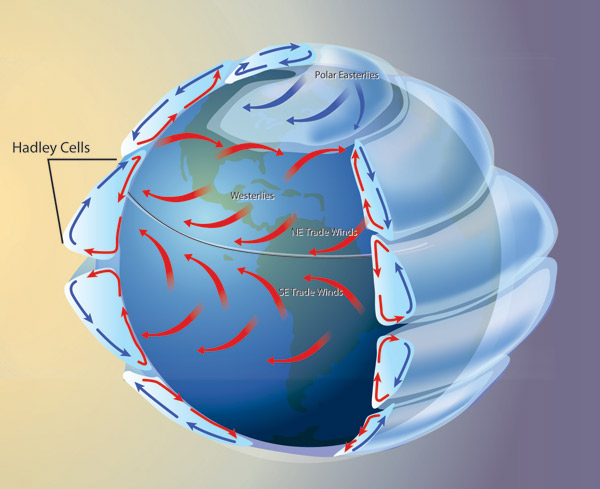
Figure 2: Hadley cells and prevailing winds
Solar warming of the tropics drives atmospheric circulation in three cells. Rotation of the Earth generates Coriolis forces that create the easterly trade winds below 30° latitude and polar easterlies higher up 60° latitude. Coriolis forces create prevailing westerlies in the mid-latitudes.
The sinking air mass at 30˚ breadth drives ii phenomena: It contributes to the germination of arid climates and drives apportionment of air northward and s of the torrid zone. Dry out, even desert-similar conditions often occur at thirty˚ north and south latitude because the descending dry air draws moisture from the soil (Figure 3). Equally warm air rises in the tropics, cool air is drawn from surrounding areas to fill the void. This creates the trade winds that blow in subtropical regions. But some of the air that descends from the Hadley jail cell is drawn away from the equator toward the poles. This air mass creates winds that characterize atmospheric condition patterns in the temperate zones.
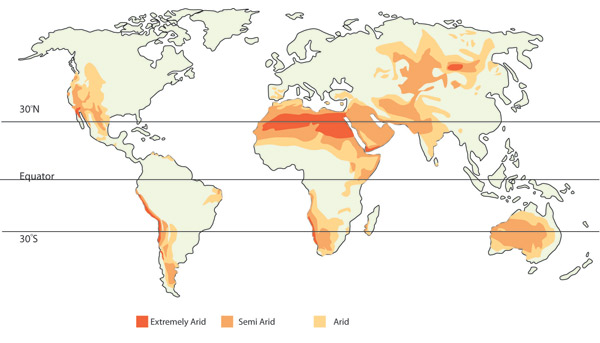
Figure 3: Distribution of barren land
Dry air descends at 30° latitude, cartoon moisture from the soil and contributing to the cosmos of barren climates.
Under the influence of Earth'due south rotation, air returning to Earth'due south surface is deflected by the Coriolis force, which shifts the menses of air to the right of its initial trajectory in the northern hemisphere and to the left of its trajectory in the southern hemisphere. Winds blowing toward the equator are deflected to the west, creating the easterly trade winds (easterly winds blow from due east to west). In the temperate zones, where the winds blow toward the poles, the Coriolis force deflects them toward the east, with prevailing westerlies (blowing from west to east) transporting most weather patterns in these temperate climes (Figure 2).
Bounding main Currents
Earth's rotation affects the oceans in a similar manner, setting up currents that flow within the ocean basins. Ocean currents are driven by surface winds, Earth's rotation, and differences in salinity.
Trade winds blow warm surface waters in tropical oceans and seas from east to west. Warm water pools along the west declension of continents, which sets upwardly a temperature slope across the ocean surface. Under normal atmospheric condition, the western Pacific is about 8°C warmer than the eastern Pacific, and this gradient contributes to the formation of clouds and precipitation in Australia, Republic of indonesia, and parts of Africa. Disruption of this temperature gradient creates the upshot known every bit El Niño.
Move of water away from the declension of Peru and Ecuador creates an upwelling, as common cold water is fatigued from below to fill the space (Effigy 4). Similar conditions occur on the westward coast of continents in the Atlantic and Indian Oceans. These regions are the primary source of mixing betwixt warmer surface waters and colder deep waters, which commonly remain separate. The upwelling of nutrient-rich water contributes to the unusually high biological productivity of the coastal waters in these regions.
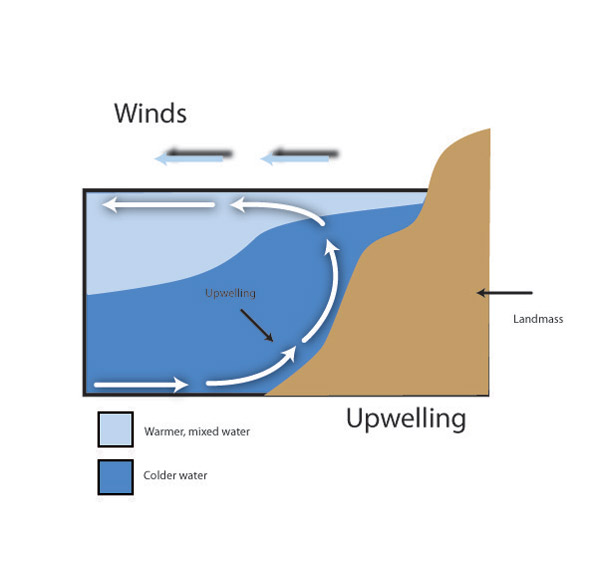
Figure 4: Upwelling
As the merchandise winds blow warm surface waters abroad from the westward coast of continents, cold, nutrient-rich water is fatigued to the surface.
But as Earth's rotation creates the prevailing winds, it creates surface currents inside the oceans. Under the influence of the trade winds, surface waters near the equator flow from east to w. As in the atmosphere, the Coriolis force causes water to be deflected away from the equator (north in the Northern Hemisphere, south in the Southern Hemisphere). This Coriolis Event sets up a rotational convection within the oceans, and currents typically menstruation in a clockwise rotation in the Northern Hemisphere and in a counter-clockwise direction in the Southern Hemisphere. As it reaches the poles, the water cools and sinks. Prevailing winds in northern and southern latitudes assistance to create cold-water surface currents that flow back toward the equator forth the w coast of continents.
Surface waters freeze as they achieve the arctic waters of the Northward Atlantic. The freezing procedure removes water molecules, but not salt, from the body of water. The result is an increase in the salinity of ocean waters. With increased salinity and decreased temperature comes greater density — h2o is densest at iv°C — and the water sinks to the ocean flooring. This process sets up a large, tedious, deep-water "conveyor belt" that transports h2o along the bounding main floor to Antarctica and then through the Indian, Pacific, and eventually Atlantic oceans.
Global Climate
The combination of oceanic and atmospheric apportionment drives global climate past redistributing rut and moisture. Areas located near the torrid zone remain warm and relatively wet throughout the yr. In temperate regions, variation in solar input drives seasonal changes. In the Northern Hemisphere where state masses are more full-bodied, these seasons can involve pronounced changes in temperature. In the Southern Hemisphere where large land masses are located nearer to the equator and the majority of Earth's surface is covered with water, seasonal cycles revolve around the presence and absenteeism of precipitation rather than major swings in temperature.
Global climate patterns are dynamic: They are continually changing in response to solar radiation, atmospheric greenhouse gas concentrations, and other climate forcing factors. Amidst the more predictable of these changes are cyclical changes in solar radiation reaching the poles. These cycles, first described by Milutin Milankovitch (1941), involve Earth's orbit, tilt, and the precession of the equinoxes.
Earth's elliptical orbit around the sunday shifts nether the gravitational pull of other planets in our solar arrangement. In a 100,000-year cycle, the orbit shifts from one that is nearly round to one that is elongated, pulling the planet further from its energy source (Figure 5A). Earth's tilt relative to its orbit changes in a 41,000-year cycle from 21.5° to 24.v°; we are currently in the middle of this cycle with a tilt of 23.5° (Figure 5B). Finally, the axis (north-south orientation) of the Earth wobbles over time. This 23,000-year precession of the equinoxes changes the orientation of the planet relative to its location in orbit (Figure 5C). When all iii Milankovitch cycles reinforce each other, they modify solar input and influence oceanic and atmospheric circulation patterns. This can lead to regular periods of cooling and glaciation.
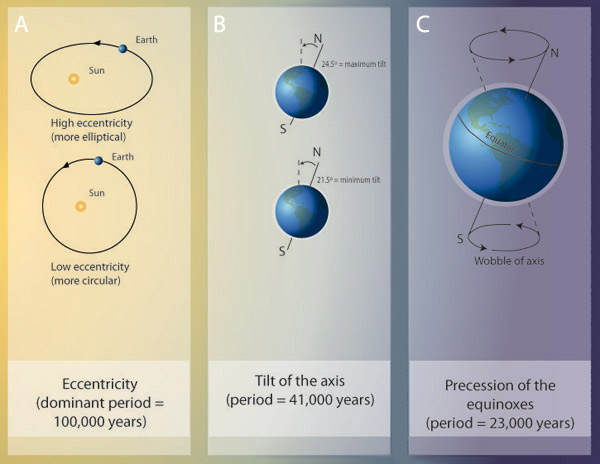
Effigy v: Milankovitch cycles
(A) High eccentricity in Earth's orbit takes it farther away from the sunday. (B) The degree of Earth'south tilt relative to its plane of orbit changes the degree of warming in the polar regions. (C) Precession of the equinoxes occurs as Earth wobbles on its axis. All three cycles tin influence warming and cooling periods by altering the amount of solar radiation that reaches World.
Periods of cooling can be intensified through albedo; the presence of snow and ice reflects incident sunlight and heat, which serves to farther cool the planet. In this way, glaciers and polar water ice caps continue to grow during periods when incident sunlight is depression. As more h2o becomes locked up as ice, the surface level of oceans drops, which can alter oceanic circulation patterns. In addition, movement of continental country masses through the processes of plate tectonics can shift the catamenia of water, altering ocean currents and circulation patterns.
As Earth's precession and tilt increment polar exposure to sunlight, rapid melting events can occur. Freed from the grip of ice, soils thaw and previously frozen vegetation decays, releasing both carbon dioxide and methane gas — ii noted greenhouse gases — into the atmosphere. Increases in carbon dioxide and methane in the atmosphere help to further warm the earth, and these gases are idea to have contributed to historical rapid warming events.
Biogeography
The current distribution of plants and animals reflects historical changes in both global climatic weather and the location of land masses. During cold periods, when much of the country was covered in snow and ice, the amount of country bachelor for terrestrial organisms to inhabit decreased, increasing contest for resource. As the ice retreated during warming events, organisms migrated to fill up newly-available areas, and many species flourished under the new environmental weather condition. Over time, organisms evolved adaptations that improve enabled them to exploit their new surroundings. Some of those adaptations persist in their modern-24-hour interval descendants.
While climatic conditions were changing, and then were the locations of big country masses as they shifted under the influence of magma currents beneath the crust. Continental collisions built mountain ranges and widening rifts became seas, both of which served to create barriers to organismal dispersal, restricting the ability of organisms to drift. Restricted to smaller areas, organisms evolved traits that best suited them to the environmental atmospheric condition of their continent and region.
Today we recognize half dozen biogeographic realms — Nearctic, Palearctic, Neotropical, Ethiopian, Oriental, and Australian — in which animals showroom features distinctive to that region (Figure 6). Realms that have experienced barriers to dispersal for longer periods of time contain animals with more distinctive traits. 1 of the best examples of this can be seen in the marsupial mammals of the Australian Region, which has a long history of isolation from other continents.
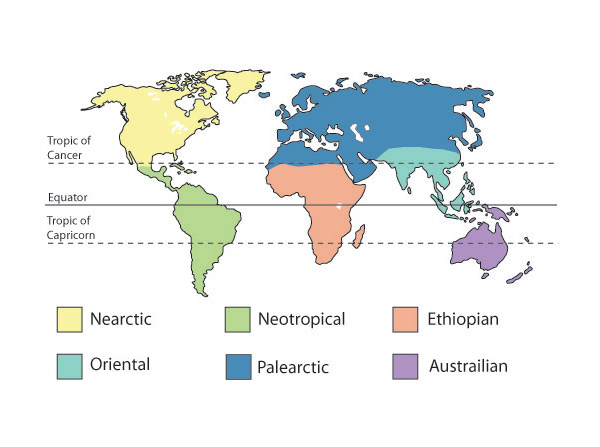
Figure 6: Biogeographic realms
Variation in climate and presence of barriers to dispersal has led to six major realms of organisms. The realms are not clearly delineated, rather species mix along boundaries.
References and Recommended Reading
Broecker, W. The neat ocean conveyor. Oceanography 4, 79–89 (1991).
Brown, J. H. & Lomolino, M. V. Biogeography, 2nd ed. Sunderland, MA: Sinauer Associates, 1998.
Campbell, N. A. et al. Biology, 7th ed. San Fransisco CA: Pearson, 2005.
Ekman, V. W. On the influence of the World's rotation on ocean currents. Arckiv för Matematik, Astronomi och Fysik 2, ane–52 (1905).
Gross, M. Yard. Oceanography: A View of Earth. Englewood Cliffs, NJ: Prentice Hall, 1993)
Holton, J. R. An Introduction to Dynamical Meteorology, fourth ed. Burlington, MA: Elsevier Academic Press, 2004.
Lutgens, F. Yard. et al. The Temper: An Introduction to Meterorology, 8th ed. Englewood Cliffs, NJ: Prentice Hall, 2001.
Milankovitch, Milutin. Catechism of Insolation and the Ice Age Trouble. Belgrade: Zavod za Udz̆benike i Nastavna Sredstva. 1941.
National Oceanic and Atmospheric Administration. NOAA Tropical Atmosphere Sea Project.
Pidwirny, M. "Surface and Subsurface Ocean Currents." In Fundamentals of Physical Geography, 2d ed. (2006).
Ruddiman, W. F. Earth's Climate: Past and Future, 2nd ed. New York, NY: W. H. Freeman and Company, 2008.
Stowe, Chiliad. S. Ocean Science. New York, NY: John Wiley & Sons, 1979.
Trefil, J. & Hazen, R. K. The Sciences: An Integrated Approach, quaternary ed. New York, NY: John Wiley & Sons, 2004.
In General, What Happens To Climate As The Latitude Increases?,
Source: https://www.nature.com/scitable/knowledge/library/factors-affecting-global-climate-17079163/
Posted by: phillipsinquen.blogspot.com


0 Response to "In General, What Happens To Climate As The Latitude Increases?"
Post a Comment